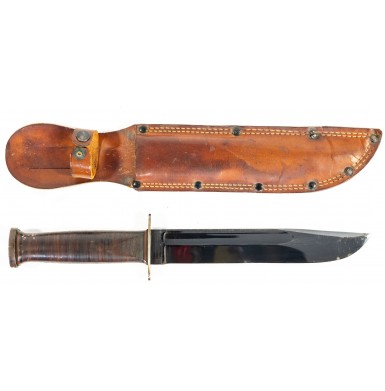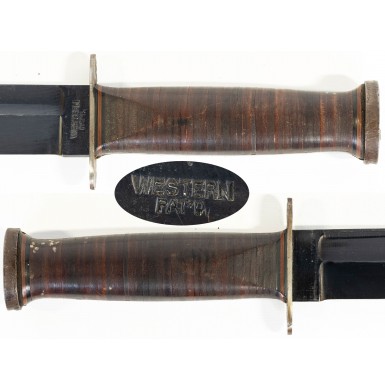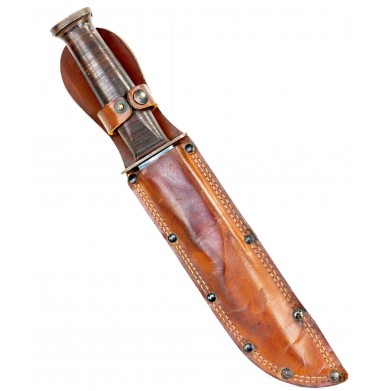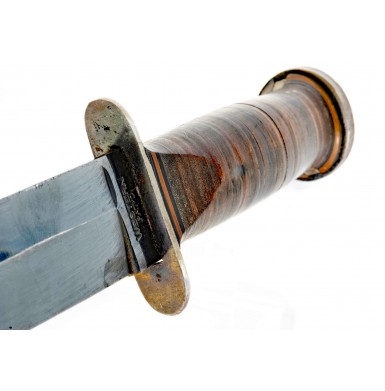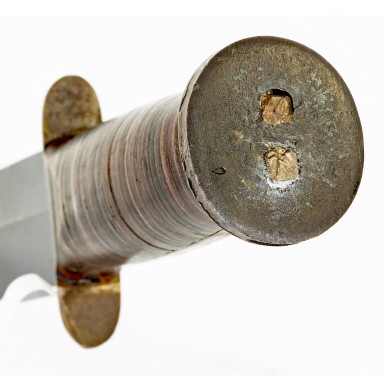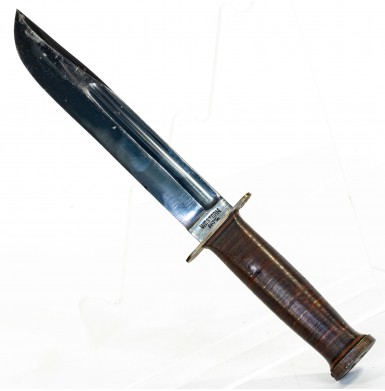Near Excellent Blued Western 8-Inch G46 World War II Fighting Knife & Scabbard
- Product Code: EWSK-GB126
- Availability: In Stock
-
$795.00
This is a NEAR EXCELLENT condition example of the World War II production fighting knife, manufactured by the Western States Cutlery & Manufacturing Company. Western Cutlery was originally founded as Platts & Sons Cutlery in Gowanda, NY, in 1896. Charles Platts, who was an immigrant from Sheffield, England, founded the company. He had been employed in the knife making trade in Sheffield and knew the manufacturing process well. Platts also spent some 30 years working as a supervisor at the Northfield Knife Company in Northfield, CT, prior to starting his own company. Platts’ pocketknife business quickly became quite successful, and after only a year in business he moved the company to Eldridge, PA. Charles Platts died in 1900, but his sons continued to run the company until 1905, when his son H.N. Platts bought out all of the family owners and moved the company to Bradford, PA. In 1911, Platts moved the company to Boulder, CO, with the intention of taking advantage of the continuing western expansion in the United States. At this time, he re-established the company with the new name: Western Cutlery & Manufacturing Company. Platts’ Boulder factory was one of the first production facilities in that city and his business continued to expand and prosper over the coming decades. Not long after moving to Boulder, Western Cutlery introduced two manufacturing trademarks – Western and West-Cut. Their primary product lines revolved around pocketknives, but they also pioneered some innovative belt knife designs, including the introduction of double tangs and aluminum end caps.
With the coming of World War II, Western Cutlery’s business expanded dramatically due to wartime production needs. Western Cutlery received a number of US government knife contracts during the war and produced thousands of combat knives during the war years. In fact, one World War II era catalog folder proclaimed:
“For the duration, the entire output of the Western factory is ear-marked for the armed forces. This folder shows some of the specially designed knives we are now making for our fighting men.”
The knives listed included knives with names like “Shark”, “Fighting”, “Parachutist”, “Commando”, “Bushman” and “Seabee”. A World War II magazine advertisement noted that the Western “Shark Knife” is an “…all-purpose knife – a fighter and a worker, ready to cut loose from wreckage, slice bread, open cans, trim toenails, kill Japs or wrest a living from a desert isle.” I find the juxtaposition of trimming toenails and killing the enemy particularly humorous. Obviously, Western Cutlery had a pretty good idea of the many tasks that a fighting-utility knife would be asked to handle in a theater of war.
In 1984 Western Cutlery was acquired by the Coleman camping equipment company, who subsequently sold its Western Cutlery assets to Camillus Cutlery in 1991. In 2007 Camillus shut down the Western Cutlery factory and the trade name ceased to exit.
This Western Fighting Knife No. G-46-8” is in about NEAR EXCELLENT condition. Although many of the Western knives produced during World War II utilized Western’s aluminum pommel cap, many of the G-46 knives incorporated a simple oval steel pommel cap that was blued and secured by peening the ends of the double tang that projected through it. According to a letter dated 19 January 1961 from Harlow C. Platts (President of Western at that time) to M.H. Cole (the famous knife maker, knife historian & author), the #46 knife was produced by the thousands during the Second World War. Platts notes in the letter, in part:
“Regarding the second knife, which is our #46 pattern, we made thousands of these both for the Army and Navy. They proved very popular, and we still get them back to be repaired or made over.”
The #46-8” had an 8” clip point blade that strongly resembled the blade of the USN Mark II knife and the USMC fighting-utility knife but was an inch longer. The majority of the knives had blued blades and pommel caps and the usual leather washer handle with most having thin red and black Bakelite spacers at both ends. While most of the knives had steel pommel caps, some were produced with aluminum ones and some of the knives were made with bright blades. The knives were delivered in sewn leather scabbards that were reinforced with rivets. The scabbard had a pair of belt loop slits in the integral frog and a, hilt-retaining strap that was secured with a snap.
This particular Western G-46-8” Fighting Knife is one of the early production knives that has a “saber ground” blade with a nominally 4 5/8” long fuller. The blade also has the thrid type marking, per Bill Walters’ samples and typology in his book US and Allied Military Knives World War II. The obverse ricasso is unmarked, and the reverse ricasso is crisply and deeply marked in two lines:
WESTERN
PAT’D.
The knife is in NEAR EXCELLENT condition and retains about 90%+ of its original deeply blued finish on the 8” blade. The loss is mostly along the high points of the blade and appears to be mostly from insertion and removal from the scabbard, along with some handling. The blade retains its original factory edge and shows no signs of sharpening, although some very light scuffing is visible on the blade surface.
The blade is free of any pitting, but there are some freckled areas of light surface oxidation here and there and a couple of tiny areas of minor surface roughness. The stamped metal crossguard and the exposed edges of the dual tangs that run down the length of the grip show some evenly distributed areas of light to moderate surface oxidation. Some of this could probably be lightly cleaned, if so desired. The pommel cap retains some minute traces of its original bright blued finish, which has flaked, with the exposed metal having oxidized to a rich brown patina. The pommel cap also shows a pair of roughly peened tangs, typical of Western knives. The hilt is in about FINE condition and the stacked leather washer grip is crisp and in very nice shape. The leather washers show only light handling marks and scuffing, along with some minor round impact marks near the pommel cap. The leather portion of the grip is bookended by a pair of black and a single red, Bakelite washers at the crossguard and pommel cap. A correct, Western Cutlery leather sheath accompanies the knife, and shows the expected two lines of stitching around the perimeter, reinforced with blackened, domed rivets. This pattern of sheath is shown as example F in Bill Walters’ book, and he notes that this is the most commonly encountered variant of Western sheath for a G-46-8 knife. The sheath is in about FINE condition and shows the wear commensurate with the use shown on the knife. The stitching is in place around the periphery of the scabbard and remains secure, although the thread does show some discoloration from age and use. All of the rivets are in place and secure as well. The hilt-retaining strap is in place as well, a feature that is often missing from these scabbards, due to use, wear, and age. The sheath retains some of its original finish, but has darkened slightly due to age, use and exposure. The leather does show a number of surface scuff and wear marks, and some scattered areas of more noticeable darkening from dirt and oil, as would be expected.
Overall, this is a really wonderful example of a real WWII production 8” Western “Fighting” Knife. These knives are very scarce today, as Western did not produce nearly as many as some of the larger blade manufacturers like Camillus and Union Cutlery (aka KaBar) did. These knives are highly sought after today for military edged weapons collections, because of their very high-quality construction and their rarity when compared to other maker’s fighting utility knives. This one has a fantastic condition blade and will be a fine addition to your collection of WWII fighting knives.
Tags: Near, Excellent, Blued, Western, 8-Inch, G46, World, War, II, Fighting, Knife, Scabbard


